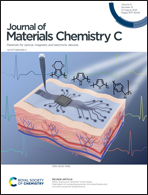UV-protection and fluorescence properties of the exoskeleton obtained from a living diatom modified by an Eu3+-complex†
Abstract
In this article, a natural biological porous material, from living diatoms, is used to prepare new UV-protection hybrid materials with an Eu3+-complex. By removing the organic protoplasm of living diatoms, the exoskeleton with a regular pore structure arrangement was obtained. The Eu3+-complex was chemically bonded to the exoskeleton modified by the silane coupling agent (3-aminopropyl)trimethoxy silane (APTMS). Compared with pure Eu3+-complexes, the fluorescence intensity of this hybrid material was increased by approximately 10 times. For illustrating its applications in the field of UV-protection, we mixed the USDU with polyacrylonitrile to produce flexible and transparent polymer films. The hybrid composite film (USDU@PAN) achieved partial absorption of ultraviolet light between 200 and 400 nm. At the same time, it also emits visible fluorescence and the intensity of the fluorescence is greatly increased. Therefore, the USDU@PAN film has wide application prospects in areas such as photoelectric sensors and UV-protection devices. More importantly, we transform natural organisms into materials with excellent optical properties. Therefore, it can be used in the field of UV-protection.



 Please wait while we load your content...
Please wait while we load your content...